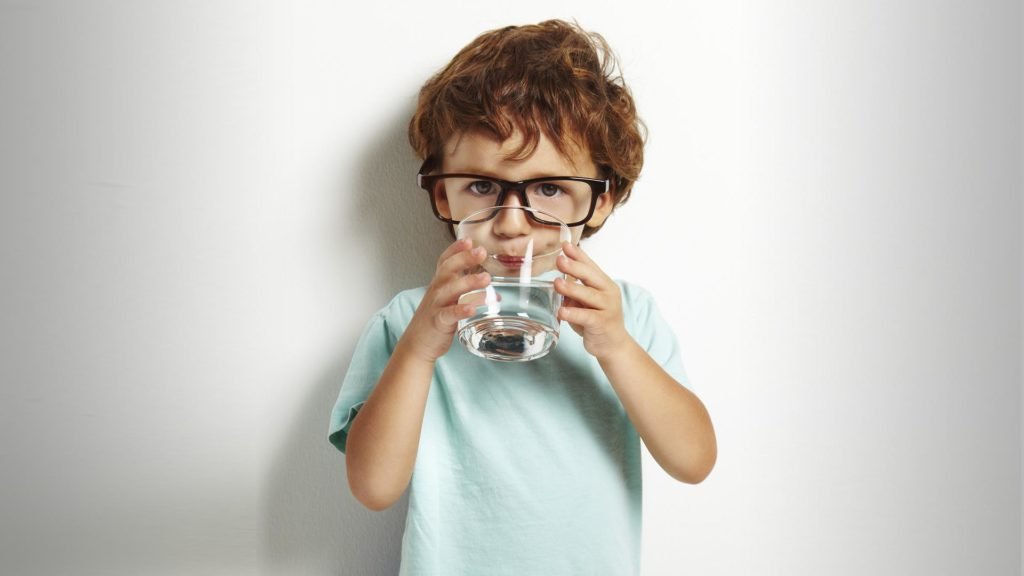
How much water is enough?
Did you know that studies indicate that the majority of children don’t drink enough water. Considering our bodies are 75% water (even more in our brain) it’s no surprise that the effects of this can affect many systems. The heat in summer makes our children especially vulnerable as they need more water. I know that if I don’t drink enough water I feel sluggish and will often get a headache.
Too little water can cause:
- Low energy or irritability
- Headaches
- Feeling dizzy or light headed
- Poor concentration
- Less urination or lighter nappies
- Dark urine
- Constipation
- Thirst
- A dry mouth
- Sunken eyes
- A low grade fever
- Rapid heart rate
- Rapid breathing
Any of these symptoms may mean that your child isn’t drinking enough water with some signalling significant dehydration. Surprisingly thirst isn’t a reliable early indicator and usually means your child is already dehydrated.
So how much water should children drink?
| Age | Water volume |
| 0-6 months | 0 |
| 6-12 months | 100 – 250ml |
| 1-2 yo | 250 – 500ml |
| 2-5 yo | 500ml – 1l |
| 5-8yo | 1 – 1.3l |
| 9-12yo | 1.3 – 1.6l |
| >13years | 1.5 – 2l |
Ultimately it depends on their age, size, activity levels as well as the weather. The overall goal is for them to wee every 3-4 hours and for their wee to be light yellow. I’m the kind of mum and doctor that prefers clear guidelines though, so here are some I’ve drawn up:
When to introduce water?
As you can see, giving water to babies under 6 months is usually discouraged. My general advice is to introduce sips of water when you start solids. Be careful not to overdo the volume and never give too close to a milk feed or a meal so they’re not full up with water. Small amounts of water may also help constipation that often occurs with starting solids.
Should I use filtered water?
We are fortunate to have safe drinking water in Australia but that doesn’t mean there are no nasties inside. There are many chemicals, heavy metals, other contaminants and disinfectants that personally I would prefer children not drink. Running water for 30 seconds prior to using helps to decrease some heavy metals like lead and copper, it doesn’t do much else. Boiling also does very little. Buying bottled water may offer cleaner water but presents it’s own problems of plastic and pollution. This is why I recommend that everyone uses a water filter. It’s particularly important for children who drink more (per kg of body weight) and are more vulnerable. The main options include carbon, reverse osmosis, ceramic and distillation. The different mechanisms have different advantages and disadvantages and also come with a variable price tag. Although I recommend doing your own research, my personal favourite is a carbon based one. But there is no perfect filter system and something is better than nothing!
10 tips to ensure good hydration
1. Know how much they should have. I find it easiest to work out how many refills of their water bottle..
2. Each child should have his/her own water bottle (I prefer stainless steel as I’m not a fan of plastic)
3. Start the day with a big glass of water
5. Drink more when sick, being very active or it’s hot
6. Set reminders on your smart phone
7. Use reward charts
8. Flavour with slices of fruit or vegetables e.g apple, lime, mint, orange,
9. Cold or warm herbal tea instead of plain water e.g. I use a calming chamomile tea for after school time
10. Cup of warmed bone broth or apple cider vinegar & honey in winter or if getting sick.
I’m lucky because my kids love water. But it’s always good to remind our children no matter the weather although I do think that the Australian summer saying should be edited to be “Slip, Slop, Slap, Sip!”.
If you’ve found this helpful please share it 🙂
